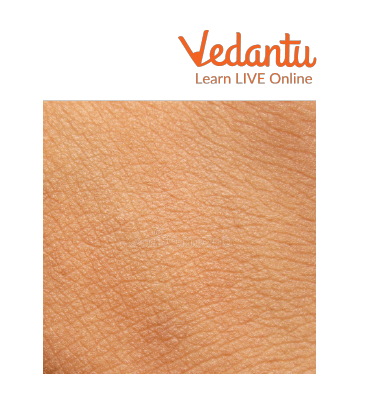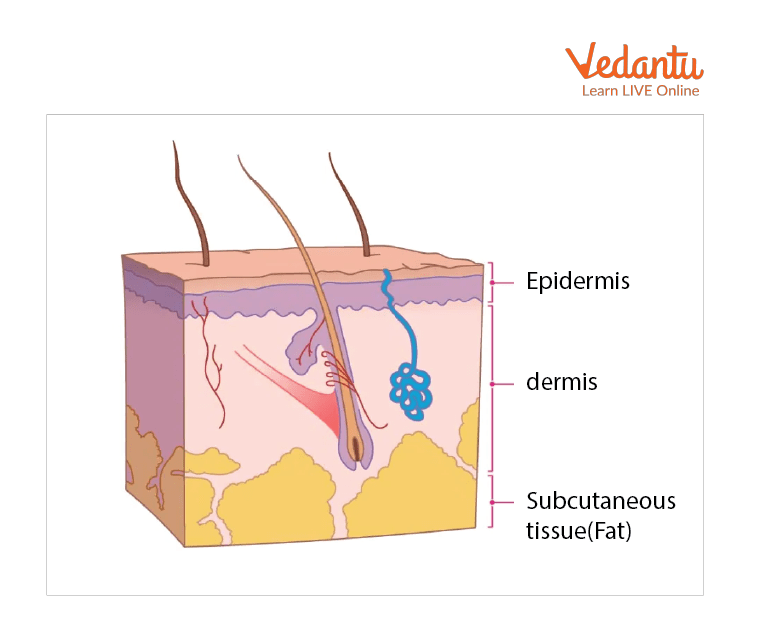




What is Skin?
It is a natural barrier, located between the external and internal environment of the body. Human skin performs many important functions and ensures the smooth functioning of the entire human body. The regulation of body temperature is also done by the skin. It also helps the lungs in respiration. Moreover, the waste products of the body keep coming out of the body through the skin in the form of sweat. Read ahead to learn more about the skin and its functions.

Human Skin
Functions of the Skin
Receptors - Receptors are organs or cells capable of translating external influences into nerve impulses and transmitting signals of this effect throughout our nervous system. The skin possesses the pain, and tactile receptors that respond to cold and heat. There are about 6 million cells per square centimetre, and 5 thousand of them will be receptors that are responsible for the perception of certain external signals.
Thermotaxis - This is a very important process that should regulate the temperature of the human body and keep it constant, regardless of environmental conditions. More than 80% of heat transfer occurs through the skin.
Protective - If there are any injuries on the skin, it must be processed to prevent the penetration of harmful substances into the human body. In addition, sweat is secreted on the surface of the skin, which is acidic and kills most bacteria.
Respiration - Thanks to the skin in the human body, gaseous exchange occurs. It is certain that through the skin we get a large amount of oxygen.
Extractor - Through the skin, waste products are removed from the body for proper functioning in the form of sweat.
Skin Structure
Epidermis: This is the outer layer of the skin, the upper layer of which consists of dead cells and the living cells below. It does not have blood vessels.
Dermis: In this layer, the branches of nerves are spread.
Sebaceous or Grease Gland: A special type of sebaceous substance is produced in this, which keeps the hair roots smooth.
Subcutaneous Fat: It protects the skin.
Erector Muscle: It keeps the hair on the skin erect.
Blood Vessel: The blood of the blood vessels absorbs oxygen from the air that comes in contact with the skin.
Sweat Glands: These produce sweat which removes waste products from the body.
Malpighian Layer: It produces a pigment called melanin. The colour of the skin is due to this substance.

Layers of Skin
Solved Questions
1. Which is the largest organ of the body?
Ans: Skin is the largest organ of the body.
2. Which is the outer layer of the skin?
Ans: The epidermis is the outer layer of the skin.
3. What is Malpighian?
Ans: The Malpighian layer produces a pigment called melanin. The colour of the skin is due to this substance.
4. What are the functions of skin?
Ans: Along with being a protective shield of the body, the skin contributes to a variety of functions, such as:
The skin protects the internal organs.
Protects against germs and toxins.
Helps to regulate body temperature.
Regulates the sensations of touch, heat and cold.
The skin participates in the synthesis of vitamin D necessary for the body.
Helps maintain water and electrolyte balance.
The skin contains an extensive network of nerve cells, which perform the function of transmitting sensations to environmental changes.
Learning by Doing
Multiple Choice Questions (MCQs)
1. Which is the biggest organ of the human body?
Brain
Heart
Skin
Liver
2. What is the pigment that gives colour to human skin?
Melanin
rhodopsin
Adoption
Anthocyanin
3. Who covers the bones and the muscles?
Skin
Liver
Heart
Stomach
Summary
Skin is a natural barrier, located between the external and internal environment of the body. The human skin performs many important functions and ensures the smooth functioning of the entire human body. The epidermis is the outer layer of the skin. The skin protects the internal organs and helps to regulate body temperature.
FAQs on The Human Body Skin: The Skin Organ and Its Functions
1. What is the thickness of the skin?
The thickness of the skin of the human body varies from 0.05 to 0.65 cm. This thickness is the lowest on the eyelids and highest on the soles. The skin has very tiny pores. Keeping these pores clean is very important to prevent infection.
2. Describe the synthetic function of the skin.
The essence of the synthetic function of the skin is that in the human skin, a special pigment melanin is synthesised, which allows it to neutralise the effects of ultraviolet radiation. Melanin is a good antioxidant. Additionally, with its help, the human body receives vitamin D, which protects it from bacterial infections and is still considered one of the best ways to combat a disease such as tuberculosis. This vitamin causes a buildup of protective peptides in the body, which activates the immune system, and kills Koch's wand.
3. What is hypodermis?
The hypodermis is the innermost layer of the skin of both animals and plants. In vertebrates, the hypodermis or subcutaneous tissue is made up of loose connective tissue and fat lobules. Therefore, fibroblasts, fat cells, and macrophages are the three main types of cells in hypodermis. It also contains blood vessels and nerves that are larger than the dermis. One of the main functions of the hypodermis of vertebrates is to store fat, which later serves as an energy source. In addition, this fat layer acts as an insulator, which helps regulate body temperature.









